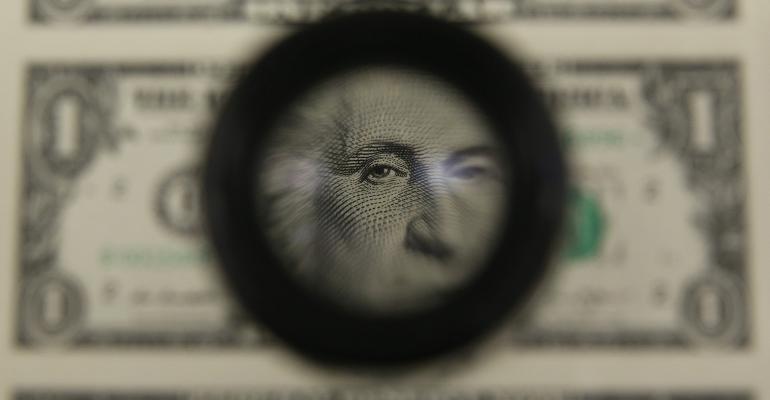With yields on sweep accounts, money market funds and savings accounts stuck near historical lows, what’s an advisor to do in trying to garner more income for clients out of their cash reserves?
Ultra-short-term bond funds—those with bonds of maturities three years or less—are one option. “They can be an interesting alternative to money-market funds, because money-market funds are restrained to 13-month maturities,” says Jack Ablin, chief investment officer at Cresset Wealth Advisors in Chicago.
Looking at the slope of the yield curve, there’s a dramatic rise from the overnight rate of 1.63 percent as of March 29, to the one-year Treasury yield of 2.09 percent, the two-year Treasury yield of 2.27 percent and the three-year Treasury yield of 2.39 percent, he notes.
“For that reason, having the ability to move beyond 13 months in an ultra-short bond fund allows you to pick up extra yield. That makes a difference in a period where yields are so low.”
The average sweep account yield was only 0.14 percent as of March 23 for accounts of $100,000, according to Crane Data, with money market yields averaging 1.24 percent. And savings accounts averaged a yield of only 0.09 percent as of March 30, according to Bankrate.
Meanwhile, ultra-short bond funds had an average yield to maturity of 2.2 percent, as of March 27, according to Morningstar Direct. “Ultra-short bond funds are a step up from money-market funds for investors looking for a bit more yield and willing to stomach somewhat higher interest-rate volatility,” says Michael Sheldon, chief investment officer at the wealth management firm RDM Financial Group in Westport, Conn.
Morningstar counts 91 ultra-short bond funds (including ETFs) in total, with combined assets of $162 billion.
But you and your clients must understand that while ultra-short bond funds are less risky than their longer-term brethren; they are riskier than money market funds. That’s because when short-term interest rates rise, such as now, the share price of an ultra-short bond fund falls, potentially wiping out the yield.
For example, “I like the Lord Abbett Short Duration Income Fund (Ticker: LALDX),” which receives Morningstar’s top five-star rating, says Ethan Anderson, a wealth adviser at Rehmann Financial in Grand Rapids, Mich. “It has done what it’s supposed to do as a cash alternative. But its total return is negative 2 basis points so far this year, which means it’s not cash.”
With the Fed in the midst of raising short-term interest rates, the share prices of ultra-short bond funds remain quite vulnerable, says Jack Riashi, a financial adviser at Bloom Asset Management in Farmington Hills, Mich.
Given that risk, your clients should plan on holding ultra-short bond funds for at least a year to ensure they benefit from the higher yields compared to money market funds, Ablin says. “If it’s money you’re looking to spend in the next few months, I would just recommend money market funds.”
Mick Heyman, an independent investment manager in San Diego, prefers utilizing brokered CDs or 90-day Treasury bills as an alternative to money market accounts. That allows you to avoid fund fees and almost guarantees you’ll receive all your principal back. The 90-day T-bill yielded 1.73 percent March 30, and one-year brokered CDs yielded about 2 percent.
“If you just want your money short and safe, you can roll CDs and average out better by not paying fees, though you’re not quite as liquid,” he says.
If your clients do opt for ultra-short bond funds, you should examine the funds’ holdings closely. “Some have a large exposure to corporate bonds,” Riashi says. “Most of them are investment grade, but some aren’t. People have to be careful to see what bonds the funds own.”
In addition, remember that you can’t use a bond fund like a cash account, which means no writing checks on the fund or using money in the fund to buy securities directly.
If after all that you’re still interested in ultra-short bond funds, Morningstar analysts give one their top gold rating: PIMCO Enhanced Short Maturity Active ETF (MINT).
“The fund has delivered strong returns versus distinct open-end and exchange-traded fund competitors, even though its less adventurous profile has caused it to sacrifice some of its open-end sibling’s gains,” writes Morningstar analyst Miriam Sjoblom. “It has also kept a lid on volatility, and its relatively cheap fees compared with the open-end universe provide another advantage.”
The fund sports a one-year return of 1.58 percent and a three-year annualized return of 1.47 percent. Its current yield is 1.89 percent, and its annual expense ratio is 0.35 percent.
Fidelity gives a silver rating to PIMCO Short-Term Institutional (PTSHX), MINT’s open-end counterpart, and a bronze rating to BBH Limited Duration (BBBIX).
To Anderson, “Ultra-short funds make a lot of sense if you recognize that they aren’t cash. They’re a cash alternative.”

